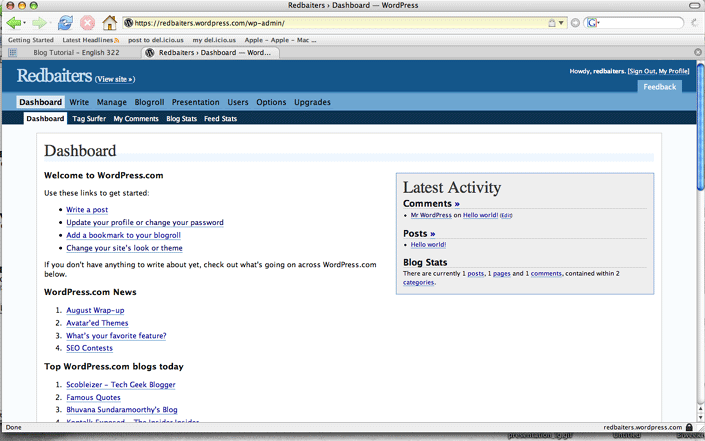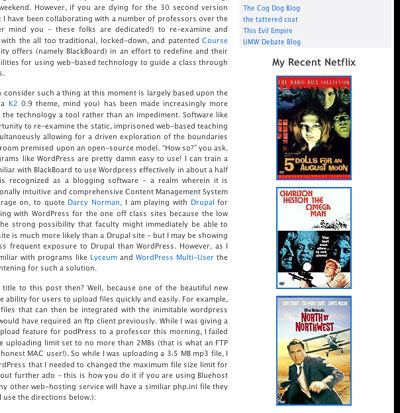… because I am so damn good. Feel free to edit it! Link.
Watch the bava blog trailer!
about
is an ongoing conversation about media of all kinds ...
Testimonials:
Generations from now, they won't call it the Internet anymore. They'll just say, "I logged on to the Jim Groom this morning.
-Joe McMahon
Everything Jim Groom touches is gold. He's like King Midas, but with the Internet.
-Serena Epstein
My understanding is that an essential requirement of the internet is to do whatever Jim Groom asks of you while you're online.
-James D. Calder
@jimgroom is the Billy Martin of edtech.
-Luke Waltzer
My 3yr old son is VERY intrigued by @jimgroom's avatar. "Is he a superhero?" "Well, yes, son, to many he is."
-Clint Lalonde
Jim Groom is a fiery man.
-Antonella Dalla Torre
“Reverend” Jim “The Bava” Groom, alias “Snake Pliskin” is a charlatan and a fraud, a self-confessed “used car salesman” clawing his way into the glamour of the education technology keynote circuit via the efforts of his oppressed minions at the University of Mary Washington’s DTLT and beyond. The monster behind educational time-sink ds106 and still recovering from his bid for hipster stardom with “Edupunk”, Jim spends his days using his dwindling credibility to sell cheap webhosting to gullible undergraduates and getting banned from YouTube for gross piracy.
I am Jim Groom
Find out more about me here.
Recent comments
- abdessamed gtumsila on Family Pictures Podcast takes on 400 Blows
- Grant on Can we talking about blogging?
- Is it bavatube or bava.tv? | bavatuesdays on YouTube, Copyright, and the ongoing Claims on our Culture
- Reverend on Can we talking about blogging?
- Kin Lane on Can we talking about blogging?
- Family Pictures Podcast takes on 400 Blows | bavatuesdays on 400 Blows
- Family Pictures Podcast takes on 400 Blows | bavatuesdays on Summer of Love: The 400 Blows
- Reverend on Is it bavatube or bava.tv?
- Reverend on Can we talking about blogging?
- Brian on Can we talking about blogging?
- Audrey on Can we talking about blogging?
- Brian on Can we talking about blogging?
- Sarah Honeychurch on Can we talking about blogging?
- Can we talking about blogging? | bavatuesdays on Bloggers Anonymous
- Andy Rush on Is it bavatube or bava.tv?
-
Recent Posts
browse the bavarchive
Contributors
some favorites
- Alan Levine
- Andy Rush
- Audrey Watters
- bava.social
- Bonnie Stewart
- Brian Lamb
- Bryan Alexander
- Chris Lott
- Clint LaLonde
- Cole Camplese
- Darcy Norman
- David Kernohan
- David Wiley
- Gardner Campbell
- GNA Garcia
- Grant Potter
- Jeffrey Keefer
- Jon Beasley-Murray
- Jon Udell
- Kate Bowles
- Kin Lane
- Laura Blankenship
- Leslie Madsen-Brooks
- Lisa M Lane
- Martha Burtis
- Martin Hawksey
- Martin Weller
- Mike Caulfield
- Mikhail Gershovich
- Mountebank
- Paul Bond
- Scott Leslie
- Serena Epstein
- Shannon Hauser
- Stephen Downes
- The OLDaily
- Tim Owens
- Tom Woodward
- Tony Hirst




 Upon completing
Upon completing  So you wanna make an online course site that is open, conversational, multimedia ready, and more conducive to an engaging and dynamic online learning environment? Well, you came to the right blog at the right time because as the monolithic administrative Course Management Systems tighten their imperial grip on anything “resembling a web interface to a database” (thanks for the line, Gardo), the open source rebellion is poised to slip through their stubby fingers. Are you ready to promote the virtues of openness, discovery, and sharing within the process of teaching and learning? Are you yearning for a way to accomplish academic goal outside the institutional logic of products like BlackBoard or WEBCT? If so, the following series of posts will be quilting together a number of open source software such as
So you wanna make an online course site that is open, conversational, multimedia ready, and more conducive to an engaging and dynamic online learning environment? Well, you came to the right blog at the right time because as the monolithic administrative Course Management Systems tighten their imperial grip on anything “resembling a web interface to a database” (thanks for the line, Gardo), the open source rebellion is poised to slip through their stubby fingers. Are you ready to promote the virtues of openness, discovery, and sharing within the process of teaching and learning? Are you yearning for a way to accomplish academic goal outside the institutional logic of products like BlackBoard or WEBCT? If so, the following series of posts will be quilting together a number of open source software such as 

 I’m finally back at the blog, and while I have been away for a while, I am happy to say that this was only because so many cool things have been happening. In fact, this post is just to frame a tiny (yet crucial) element of a larger push by the faculty I work with at UMW to re-imagine the relationship of the web to their research, teaching, and learning practices. While each of these projects have much in common, they are all particular enough that they will need a more sustained tracing of the development, planning and final product on this blog, something I plan to begin this weekend. However, if you are dying for the 30 second version -which I know you are- here it is: I have been collaborating with a number of professors over the past month (during the Summer mind you – these folks are dedicated!) to re-examine and re-imagine what they are doing with the all too traditional, locked-down, and patented
I’m finally back at the blog, and while I have been away for a while, I am happy to say that this was only because so many cool things have been happening. In fact, this post is just to frame a tiny (yet crucial) element of a larger push by the faculty I work with at UMW to re-imagine the relationship of the web to their research, teaching, and learning practices. While each of these projects have much in common, they are all particular enough that they will need a more sustained tracing of the development, planning and final product on this blog, something I plan to begin this weekend. However, if you are dying for the 30 second version -which I know you are- here it is: I have been collaborating with a number of professors over the past month (during the Summer mind you – these folks are dedicated!) to re-examine and re-imagine what they are doing with the all too traditional, locked-down, and patented  I just went to the
I just went to the 